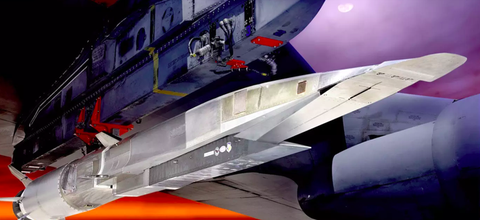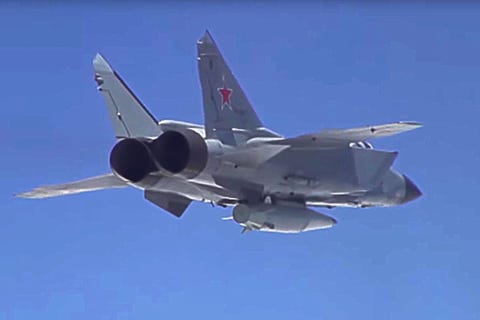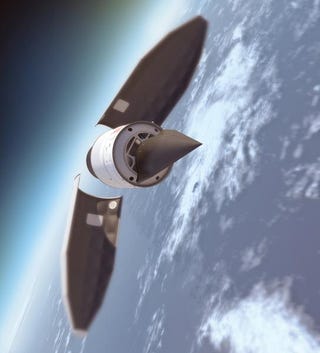The First U.S. Hypersonic Weapons: Arrow and Hacksaw
The U.S. is racing to catch up with Russian and Chinese hypersonic weapons.
By Kyle Mizokami USAF
USAFThe U.S. Air Force has awarded contracts to defense giant Lockheed Martin to develop two new hypersonic weapon systems. The contracts are in response to the rapid development of hypersonics in Russia and China, a development that could challenge U.S. technological superiority.
The first weapon, the AGM-183A Advanced Rapid Response Weapon (ARRW, pronounced “Arrow”) is an outgrowth of the DARPA’s Tactical Boost Glide program. ARRW is a rocket carried aloft by an aircraft such as a B-52 bomber and has a top speed of up to Mach 20. This makes it up to four times faster than Russian and Chinese hypersonic weapons, including Starry Sky 2 and Kinzhal. The Air Force recently awarded Lockheed Martin a $480 million contract to develop the ARRW, with an eye towards operational capability in 2021.

Kinzhal, a tactical ballistic missile launched from a MiG-31 interceptor that flies at hypersonic speeds.
GETTY IMAGESRUSSIAN MINISTRY OF DEFENSE
The second weapon is the Hypersonic Conventional Strike Weapon (HCSW, or “Hacksaw”). A solid fuel rocket with GPS guidance, HCSW is also designed to be carried by aircraft with a planned in-service date of 2022. Lockheed Martin received $928 million to work on Hacksaw in April 2018.
These aren’t the Pentagon’s only hypersonic projects. DARPA’s Tactical Boost Glide, a weapon with a 500 nautical mile range, is set to begin flight tests in 2019. DARPA is also working on the Hypersonic Air-breathing Weapon Concept (HAWC), which uses scramjet engines to cruise at hypersonic speeds. The U.S. Navy tested an unnamed boost glide weapon in November 2017.
Hypersonic weapons are the new frontier in warfare and they come in two types: boost glide weapons and powered atmospheric weapons. Boost glide weapons—a category that includes Arrow, Tactical Boost Glide, and apparently Hacksaw—are unpowered weapons boosted to high altitudes by rockets and released to glide down to target at hypersonic speeds—hence the name. Powered atmospheric weapons use engines such as scramjets for propulsion.
Hypersonics are useful because their extremely high speed shortens a defender’s reaction time, and their speed and flight profile make it difficult for conventional air and missile defenses to intercept. A Mach 20 hypersonic weapon travels at a blistering 15,340 miles an hour, fast enough to go from Portland, Oregon to Portland, Maine in just over ten minutes. That gives the enemy very little time to detect, track, and shoot the weapon down.
Furthermore, a hypersonic weapon’s attack vector makes it technically difficult to shoot down. A boost glide weapon is released at very high altitudes but stops short of entering space like a ballistic missile warhead. As a result, ballistic missile interceptors are unable to shoot them down. Even in the atmosphere, fighter jets and surface to air missiles would have a very difficult time shooting down such a fast-moving target.

Tactical Boost Glide
DARPA
Arrow, Hacksaw, and Tactical Boost Glide sound similar, but there must be some key differences for the Pentagon to fund them all. A potential distinction is that Tactical Boost Glide is meant to attack enemy conventional targets near the front line—think headquarters units, air defense missiles, ballistic missiles—any important, mobile target. Hacksaw might have a longer range to attack targets across continents. Arrow notably does not have “conventional” or “tactical” in it is name, suggesting it could be a nuclear delivery system.
The hype around Russian and Chinese hypersonic weapons, with names such as Avangard, Kinzhal, DF-ZF, and Starry Sky 2, can suggest that the U.S. has somehow fallen behind these countries in hypersonic weapon research. That’s not necessarily true, given the existing Navy and DARPA programs and the relatively quick development of the Air Force’s two new programs. The U.S. could go from one tested weapon in 2017 to up to four different weapons by 2022 if all goes according to plan.
No comments:
Post a Comment